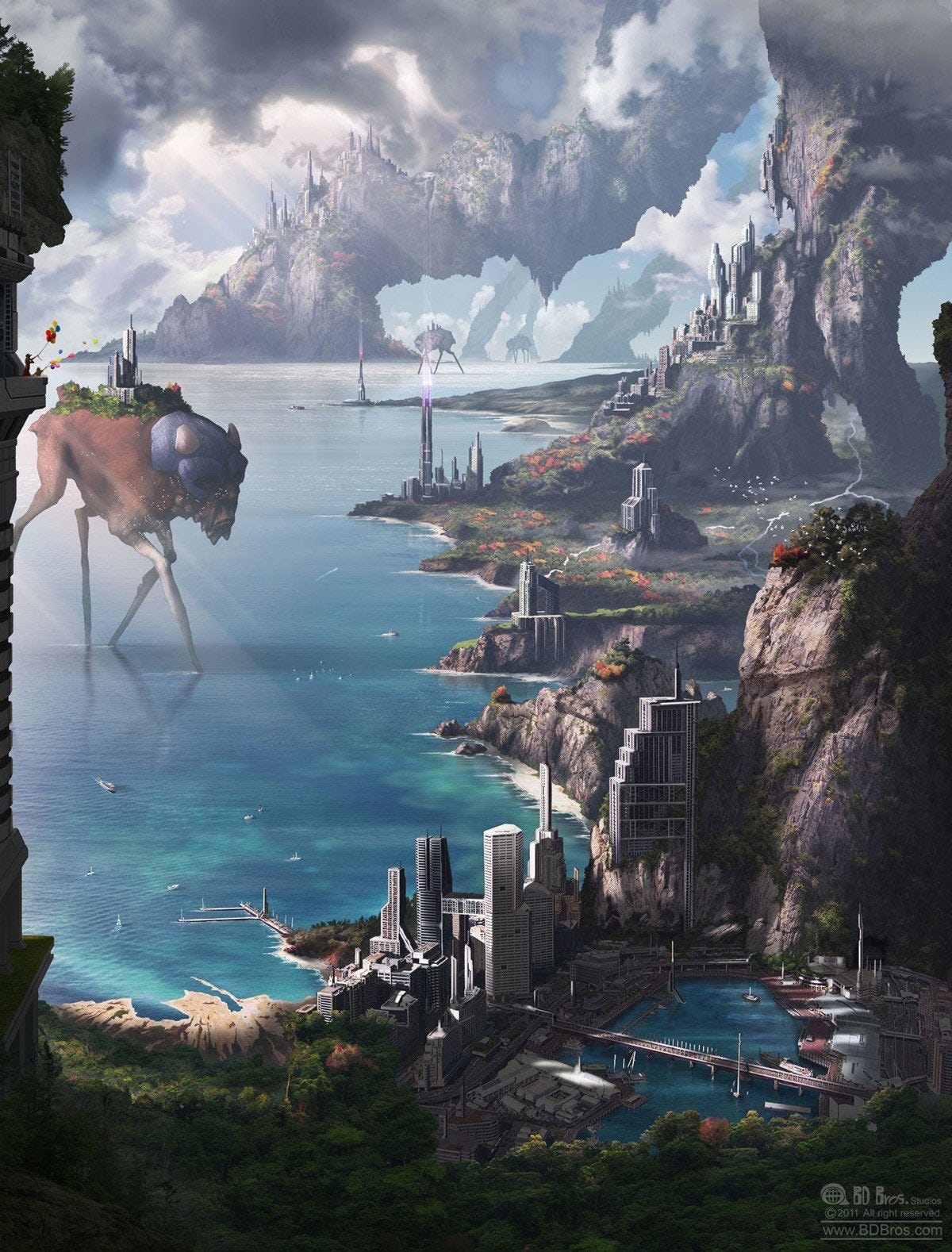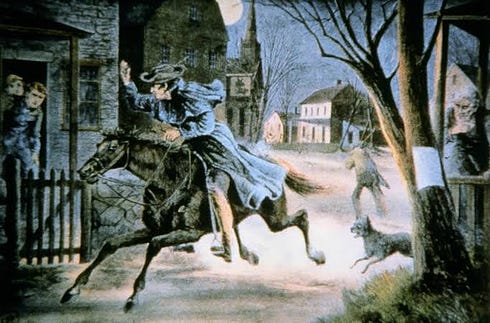Feake Hills, Crooked Waters - The Issue with Myths
Open in browser
Are we dreaming?“The American dream;” you hear about it all the time. I wonder if we’ve always taken it the wrong way. A dream can be an aspiration, sure. That’s how we generally think of “the American dream.” It’s what you can aim for, hope for, strive for, and maybe even reach. But dreams are something else, too. A land apart from reality. A mental environment, untethered from the waking world. People in this country seem particularly adept at denial, selective perception, and many of them really do live, as far as I can tell, in some kind of fantasy land. A dreamscape. Another way to think of “the American dream.” The Myth TakeWhy do myths so often overtake true tellings? In ancient days it’s easier to see the difference between myths and reality because the ancient myths (Hercules, Gilgamesh, Pandora) were what we’ve since called fiction. Maybe we’re just being too picky; I don’t know. But it’s July 4 today, when US citizens often celebrate the origin stories we’ve been told about the nation. And yet…those stories aren’t true. There are a lot of US flags waving today, and nearly everybody learned in elementary school the story of Betsy Ross making the very first US flag — for George Washington himself, no less! That story didn’t come from 1776, when the first flags were being made. It comes from nearly a century later, when Ross’ grandson William Canby wrote a paper making the very first claim that his grandmother had made the first flag. But flag makers got paid, and the payment records are still around. The receipt mentioning Betsy Ross (who was one of several flag makers at the time) says this: “Ships colours” are ensigns, banners, and pennants (long narrow flags). Especially in those days, ships’ colors were not the same thing as the flag an army would use. They had lots of rules about flags back then. Two other details in the Betsy Ross myth are that using stars with five points instead of six was her idea, and that she came up with the overall design for the flag featuring stars and stripes. Once again we can rely on the bean counters; there are letters — invoices, basically — submitted to the Continental Congress requesting payment for designing the flag. The letters were written by Francis Hopkinson, who also designed the Great Seal. Those are the only records of the sort that come from the actual time when the first US flag was being created. Not a single aspect of the Betsy Ross story appeared until decades later, and well after the death of Ross and everybody else involved. In elementary school I was also taught that George Washington, a man of mythic proportions in the US pantheon, did things like throw a silver dollar clear across the Potomac River as a young man. Washington was a big guy and probably in good physical shape, but it would have been hard for him to throw a silver dollar, because the first silver dollars didn’t exist until 1794. Washington was still alive in 1794, but he was 62 years old. Another little detail about the story is that the Potomac River is a mile wide, and was even in those days. Nobody has ever been able to throw something that far. Just to add one more bit of shade to this, back in the 1700s a dollar was a significant amount of money, even to a plantation owner. Throwing one across a river, where you’d be unlikely to be able to retrieve it, isn’t impossible, but would an eminently sensible chap like George Washington be that profligate? Kind of flies in the face of the myth, don’t you think? Another Washington myth that my teachers passed along (with completely straight faces, by the way) was that story about him chopping down a cherry tree and then admitting it with the famous words “I cannot tell a lie.” This supposedly happened when George was just six years old and received a hatchet as a gift. It’s possible…but Washington himself never mentioned it, and the story didn’t appear until 1806 (a few years after Washington’s death). It showed up in a book by Mason Locke Weems, who wrote The Life of Washington in 1800. It became a bestseller. But it didn’t contain the cherry tree story until later, when Weems was making changes for the sixth edition. He attributed the story to an “anonymous source.” So…could have happened, I guess. I live a few miles from Concord, Massachusetts, one of the waypoints on the famous “midnight ride of Paul Revere.” You remember that one; he galloped along yelling “the British are coming” in order to warn everybody. He did not. He might have undertaken some sort of trek warning about soldiers, but he wouldn’t have said anything like “the British are coming,” because at the time, the colonists considered themselves British. Also, if anything like this really happened, it would have been a secret reconnoissance mission and nobody was going to be yelling anything. This particular myth was invented 85 years after the fact by Henry Wadsworth Longfellow, who made his living selling his writing (just like Mason Locke Weems). If we celebrate this ride today, we’re celebrating the equivalent of a Tom Clancy novel. By the way, as I’m writing this it’s July 4 — the day the US celebrates the “founding fathers” signing the Declaration of Independence. Except that’s another myth. You’ve probably seen an oil painting of a bunch of white men crowded around, signing the document on July 4. Never happened. The Continental Congress ratified the document on July 4. The official version, which you can see in the National Archives, was another copy that wasn’t even created until July, and not signed until August. I think I’ve made my point that the “history” we’re taught (by people who should, and even maybe do, know better) is a set of fictional episodes invented in order to persuade people to embrace a particular world view. If there’s a true fact that can be used as the basis for a myth, fine, but really there’s no need for facts. We’re perfectly happy with stories, because that’s how we understand the world. A story, a myth, is simpler and more understandable than most aspects of reality. If your aim is to produce an emotional response in your human audience, stories are the way to go. Claiming objective truth is optional — and not only is it probably not needed, it can present problems. Annoying people like me might check the records — or think about the details, like how far can a human arm propel an object, and raise questions. But there’s something odd about those questions — they’ll be largely ignored. Our minds grasp stories and myths so tenaciously that even knowing they’re not objectively true often doesn’t seem to matter. I think that’s a problem, but not impossible to solve. Look at the truth and reconciliation process in South Africa (and Canada, Peru, South Korea, Nepal, Myanmar, Germany, etc). Simply telling the truth about something that happened; something that people did, can have surprising and positive results. One of our US myths even highlights this; it was George Washington who told the truth about that cherry tree. I think a truth and reconciliation process here would help a lot. It could begin to address racism. Policing. Incarceration. Inequality. Maybe even the elephant in the nation: slavery, even though there are no participants left. And yet I can’t imagine a truth and reconciliation process happening here. Stories are too strong in the US; I think we live less in the real world than most everybody else. The myths and characters of our shared fictional land, from cowboys (who didn’t, by the way, wear those hats) to the Music Man and all the purveyors like him of talk and promises — I think at this point they’re more powerful, more real, than we are. The story of the US is just that; a story. In this vast land that we see as empty because we learn to look elsewhere with other eyes, all we can any longer perceive are shadows and hints that anything is there outside the pages we’ve chosen to inhabit. We live in a story, not reality. We dwell in a book. Not believing it is a book that might be cast aside or abandoned. Where will we live then? Tales from…well, somewhereArthur and Belinda Gray were taking their children, Thad, Ronnie, Lila, and Suzy, on a vacation trip to the capital city to take in all the historic sights and scenery. They were almost there and the children were so excited their tails were twitching. They'd been waiting for this trip for weeks -- it was a trip almost every squirrel child hoped for, and they'd talked about nothing else for days. "Are we there yet?" asked Suzy, who was the youngest. "Almost; just a few more minutes. And look over there, children," said Belinda, pointing, "I think that might be the first family's nest, high up in that big oak tree!” The squirrel children climbed over each other to see and Arthur grimaced as the noise level in the car rose with their excited chatter. "Keep it down, please!" he said. Just as quickly the children jumped to the other side of the car as they passed the Acorn Maple. It was the famous tree where the founding squirrels hid their original cache of acorns. The children had learned the story of how Benjamin Bunny, a great friend of founding squirrel Bartholomew Nutkin, had suggested hiding the acorns in a different sort of tree in order to confuse the native Chipmunks. It had worked, as they all knew from the annual celebration of Maple Tree Day. Earlier that year Ronnie had won the Maple Tree Acorn Hunt, and he was still proudly wearing his gold medal. Arthur parked the car carefully (it was a brand-new Woods Rover in shiny Fur Gray and so far it didn’t have a single dent) and everyone piled out and headed up the Capitol Elm. Congress was in session up at the top just under the Leaf Dome, and the children were eager to sit in the gallery to watch. They didn't last long, though; they realized in just a few minutes there wasn't anything to watch besides distinguished squirrels debating each other. Not wanting to create a scene trying to keep the kids quiet, Arthur and Belinda herded them out and down the tree to the next site. Next they came to the Skyway, the famous route of branches, leaps, and grabs that circled the whole capital city. The children hadn't seen such a busy thoroughfare before, and Ronnie and Thad frightened Belinda by dashing at top speed around the Skyway, nearly crashing into other sightseeing squirrels right and left. "Don't worry, dear," said Arthur reassuringly, "they'll be fine. Let them burn off some of that excess energy; they'll be able to calm down for the rest of the day." "I know they're fine," sighed Belinda, "I just can't help worrying.” They collected the children by announcing it was time for lunch. The kids had been waiting for that too, and knew they were headed for the capital-city restaurant that had been there for so long it was almost part of the mythology of the capital itself -- the Interforest House of Pecans. Arthur and Belinda enjoyed a selection of rare nuts, and rolled their eyes at the children's choices of their favorite ordinary nuts. "You can get those at home," said Belinda. "Yup," said Lila, stuffing more nuts into her cheeks, "but not as many!" She hummed a "ta-daaa!" fanfare, and Arthur drummed on the steering wheel. "Wake up! Wake up!" he called to the squirrel children. "Open your eyes for your first look! Over there!” The children all woke up at the same time and looked where Arther pointed. "OOooooh!" yelled Suzy. “Lookylookylooky!" Thad, who was the oldest, just said “Wow." "That's right, everybody!" said Arthur, "that's where we're going next! The Cashew of Liberty!" If you liked this issue of Feake Hills, Crooked Waters, please share it! |
Older messages
The Issue with Interpretation
Sunday, July 3, 2022
It depends on what it depends on
The Dog-eared Issue
Tuesday, June 28, 2022
Revisited again and again?
Anger
Sunday, June 26, 2022
Who are these people?
The Issue of Stories
Sunday, June 26, 2022
The Tale of Tales What is the story of the three little pigs? The tale of Luke Skywalker? Holden Caulfield? If you walk into a movie without knowing what it is or who's in it, and the first scene
The Annoyed Issue
Monday, June 20, 2022
All you kids get off my lawn!
You Might Also Like
Community Tickets: Advanced Scrum Master (PSM II) Class of March 26-27, 2025
Tuesday, March 4, 2025
Save 50 % on the Regular Price ͏ ͏ ͏ ͏ ͏ ͏ ͏ ͏ ͏ ͏ ͏ ͏ ͏ ͏ ͏ ͏ ͏ ͏ ͏ ͏ ͏ ͏ ͏ ͏ ͏ ͏ ͏ ͏ ͏ ͏ ͏ ͏ ͏ ͏ ͏ ͏ ͏ ͏ ͏ ͏ ͏ ͏ ͏ ͏ ͏ ͏ ͏ ͏ ͏ ͏ ͏ ͏ ͏ ͏ ͏ ͏ ͏ ͏ ͏ ͏ ͏ ͏ ͏ ͏ ͏ ͏ ͏ ͏ ͏ ͏ ͏ ͏ ͏ ͏ ͏ ͏ ͏ ͏ ͏ ͏ ͏ ͏ ͏ ͏ ͏
eBook & Paperback • Demystifying Hospice: The Secrets to Navigating End-of-Life Care by Barbara Petersen
Monday, March 3, 2025
Author Spots • Kindle • Paperback Welcome to ContentMo's Book of the Day "Barbara
How Homer Simpson's Comical Gluttony Saved Lives
Monday, March 3, 2025
But not Ozzie Smith's. He's still lost, right?
🧙♂️ Why I Ditched Facebook and Thinkific for Circle (Business Deep Dive)
Monday, March 3, 2025
Plus Chad's $50k WIN ͏ ͏ ͏ ͏ ͏ ͏ ͏ ͏ ͏ ͏ ͏ ͏ ͏ ͏ ͏ ͏ ͏ ͏ ͏ ͏ ͏ ͏ ͏ ͏ ͏ ͏ ͏ ͏ ͏ ͏ ͏ ͏ ͏ ͏ ͏ ͏ ͏ ͏ ͏ ͏ ͏ ͏ ͏ ͏ ͏ ͏ ͏ ͏ ͏ ͏ ͏ ͏ ͏ ͏ ͏ ͏ ͏ ͏ ͏ ͏ ͏ ͏ ͏ ͏ ͏ ͏ ͏ ͏ ͏ ͏ ͏ ͏ ͏ ͏ ͏ ͏ ͏ ͏ ͏ ͏ ͏ ͏ ͏ ͏ ͏ ͏ ͏ ͏
I'd like to buy Stripe shares
Monday, March 3, 2025
Hi all, I'm interested in buying Stripe shares. If you know anyone who's interested in selling I'd love an intro. I'm open to buying direct shares or via an SPV (0/0 structure, no
What GenAI is doing to the Content Quality Bell Curve
Monday, March 3, 2025
Generative AI makes it easy to create mediocre content at scale. That means, most of the web will become mediocre content, and you need to work harder to stand out. ͏ ͏ ͏ ͏ ͏ ͏ ͏ ͏ ͏ ͏ ͏ ͏ ͏ ͏ ͏ ͏ ͏ ͏
mRNA breakthrough for cancer treatment, AI of the week, Commitment
Monday, March 3, 2025
A revolutionary mRNA breakthrough could redefine medicine by making treatments more effective, durable, and precise; AI sees major leaps with emotional speech, video generation, and smarter models; and
• Affordable #KU Kindle Unlimited eBook Promos for Writers •
Monday, March 3, 2025
Affordable KU Book Promos "I'm amazed in this day and age there are still people around who treat you so kindly and go the extra mile when you need assistance. If you have any qualms about
The stuff that matters
Sunday, March 2, 2025
Plus, how to build a content library, get clients from social media, and go viral on Substack. ͏ ͏ ͏ ͏ ͏ ͏ ͏ ͏ ͏ ͏ ͏ ͏ ͏ ͏ ͏ ͏ ͏ ͏ ͏ ͏ ͏ ͏ ͏ ͏ ͏ ͏ ͏ ͏ ͏ ͏ ͏ ͏ ͏ ͏ ͏ ͏ ͏ ͏ ͏ ͏ ͏ ͏ ͏ ͏ ͏ ͏ ͏ ͏ ͏ ͏ ͏ ͏ ͏
Food for Agile Thought #482: No Place to Hide from AI, Cagan’s Vision For Product Teams, Distrust Breeds Distrust
Sunday, March 2, 2025
Also: Product Off-Roadmap; AI for PMs; Why Rewrites Fail; GPT 4.5 ͏ ͏ ͏ ͏ ͏ ͏ ͏ ͏ ͏ ͏ ͏ ͏ ͏ ͏ ͏ ͏ ͏ ͏ ͏ ͏ ͏ ͏ ͏ ͏ ͏ ͏ ͏ ͏ ͏ ͏ ͏ ͏ ͏ ͏ ͏ ͏ ͏ ͏ ͏ ͏ ͏ ͏ ͏ ͏ ͏ ͏ ͏ ͏ ͏ ͏ ͏ ͏ ͏ ͏ ͏ ͏ ͏ ͏ ͏ ͏ ͏ ͏ ͏ ͏ ͏ ͏ ͏ ͏





